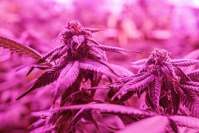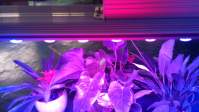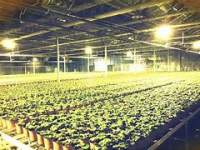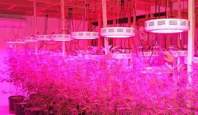For a long time, sodium lamps have been considered the gold standard for plant lighting-no other light source can achieve such a high light output. With the development of LED technology, the emergence of 800w LED plant lights is about to surpass other traditional plant lights.
What is the use of plant lighting?
Together with water and carbon dioxide, light is one of the most important components of plant growth. With the help of green chlorophyll, plants convert sunlight into nutrients-a process known as photosynthesis. If the leaves do not get enough high-quality light, growth will be hindered and the vitality of the plant will be weakened.
What kind of light does plants need?
Not all lights are the same. Because physically, it is composed of electromagnetic waves. The length of these waves determines the color of light, and not every color can be used well for photosynthesis. The area available to plants is called PAR (photosynthetically active radiation), which is between 380 and 780 nanometers. The green light in the middle area is less effective because most of it is reflected by the green leaves.
In order to measure the amount of light emitted by the lamp (which is useful for plants), the PPFD value is used: this value indicates how many effective wavelength photons are emitted. When comparing, the PPFD value should always be used, as this only indicates how much light related to growth is emitted. Wattage or lumens has only limited meaning here.
Which lamps have been used for plant cultivation up to now?
Many different light sources are used for the growth of indoor plants. The problem is that those high-brightness lamps also have very high power consumption and a lot of heat. The following light sources have been or are very common:
Fluorescent tubes: They consume relatively little power, but do not produce great brightness. For many application areas of plant cultivation, lamps with higher light output are required.
Metal halide lamps: They are much brighter than fluorescent tubes and emit white light close to natural sunlight. But with high power consumption, the lamp will be hotter.
Sodium vapor lamps: They have the best light output of all plant lamps, so they are very popular in situations where daylight must be completely replaced.
They have some disadvantages: Sodium vapor lamps can become very hot and therefore require an additional powerful cooling system. They also consume a lot of electricity, and their light tends to move in the reddish spectral range, which is not ideal for the growth of most plants.
So how does the 800w LED plant light stand out?
In order to make the LED (Light Emitting Diode) emit light, current must pass through the coated chip. The chip contains semiconductor crystals, which start to emit light when exposed to voltage. A single diode always emits a special color of light; by combining multiple diodes, the light quality can be accurately determined, which will give plants a better spectrum for growth, and the plants will grow better.
What is the difference between 800w LED plant light and traditional light?
The cost of buying 800wLED plant lights is still much more expensive than sodium vapor lights. But the performance of 800wLED plant light is much better than traditional plant growth light:
The spectrum is fully adjustable: by mixing different LED light sources, the color of the light can be precisely adjusted according to the needs of the factory. Can produce light with high blue or red components, and can omit ineffective green light. Accurately generate the spectrum used by plants. 800wLED plant light is characterized by a particularly high PPFD value.
Adapt to the needs of the spectrum at all stages: The optimal light color of many plants depends on the growth period they are in. 800wLED plant lights can be used to meet these different needs. For example, many LED plant growth lights have a switch that can switch between the vegetation stage and the flowering stage.
Low heat generation: 800wLED plant lights hardly become hot during operation, which is a great advantage, especially when compared with metal halide lamps or sodium vapor lamps. This can also save a lot of money and energy, you will have to spend on cooling. It also has the advantage that the lamp can be placed close to the plant.
Low power consumption: 800wLED plant lights are also more economical than sodium vapor lights in terms of power consumption: electricity costs can be reduced by up to 80%. This means that during a longer operating period, the operating cost of using LED lighting is lower than the operating cost of using other lights.
Practical functions of 800wLED plant light:
1. Use LED plant lights to illuminate plants: extend the light time and reduce the growth cycle of plants;
2. It can effectively prevent overgrowth of plants and grow more orderly;
3. It can increase crop yield and economic benefits;
4. It can effectively prevent the invasion of pests;
5. Promote flowering and fruiting of melon and fruit plants and reduce the formation of deformed fruits;
6. It can completely replace sunlight, and the plants can thrive when planting plants in winter;
7. It can effectively promote the formation of chlorophyll, anthocyanin and carotene required for plant photosynthesis;
8. It can be used for space plant system and space planting;
9. Wide application environment, such as large-scale planting, multi-layer tissue culture, local lighting, home bonsai, etc.
800wLED plant light application advantages:
1. It can be well applied to tissue culture, and can be illuminated at close range, especially with LED plant lights;
2. The wavelength can be customized, which can replace high-pressure sodium lamps, halogen lamps, and fluorescent lamps with 3-5 times the power, saving 80% of electric energy;
3. Long life span, up to 50,000 hours;
4. The ratio of lamp beads can be freely matched to meet the needs of different plants and different growth stages;
5. It can control the growth rate of plants and predict the maturity time of the market;
6. It is an energy-saving, environmentally-friendly and efficient plant growth lamp.
7. The heat emitted is much lower than traditional plant growth lamps.
8. Faster response speed than traditional plant growth lights;
9. It is stronger than traditional plant growth lamps and has stronger impact resistance.
Recent developments have enabled 800wLED plant light lighting technology to "make a big splash" in the field of plant cultivation and supplement light. In terms of light output and other aspects, 800wLED plant lights are now almost more advantageous than traditional sodium vapor lights, and they are more energy-efficient.






